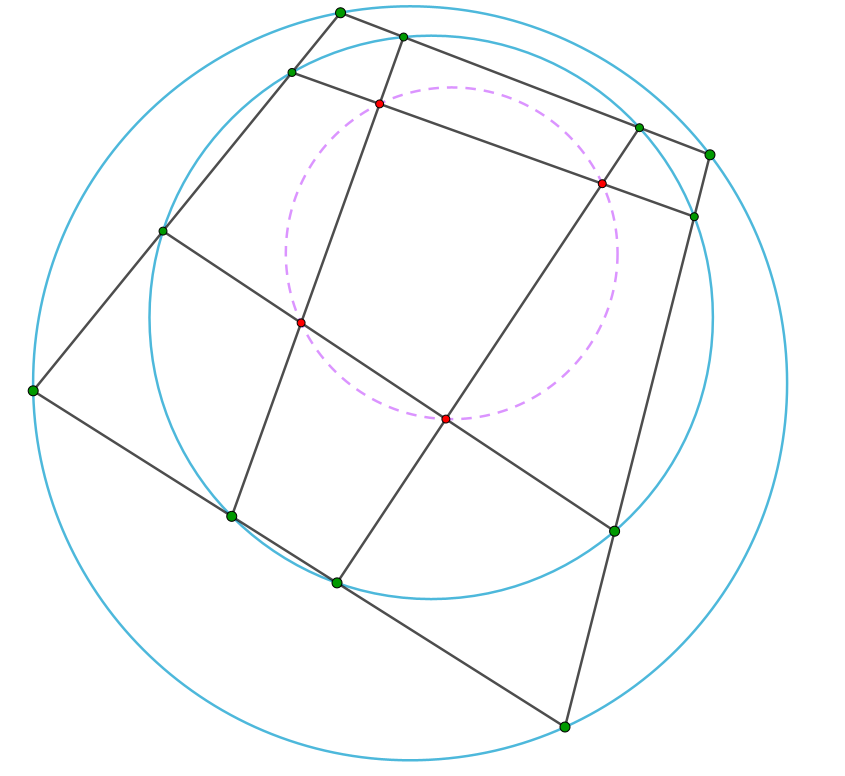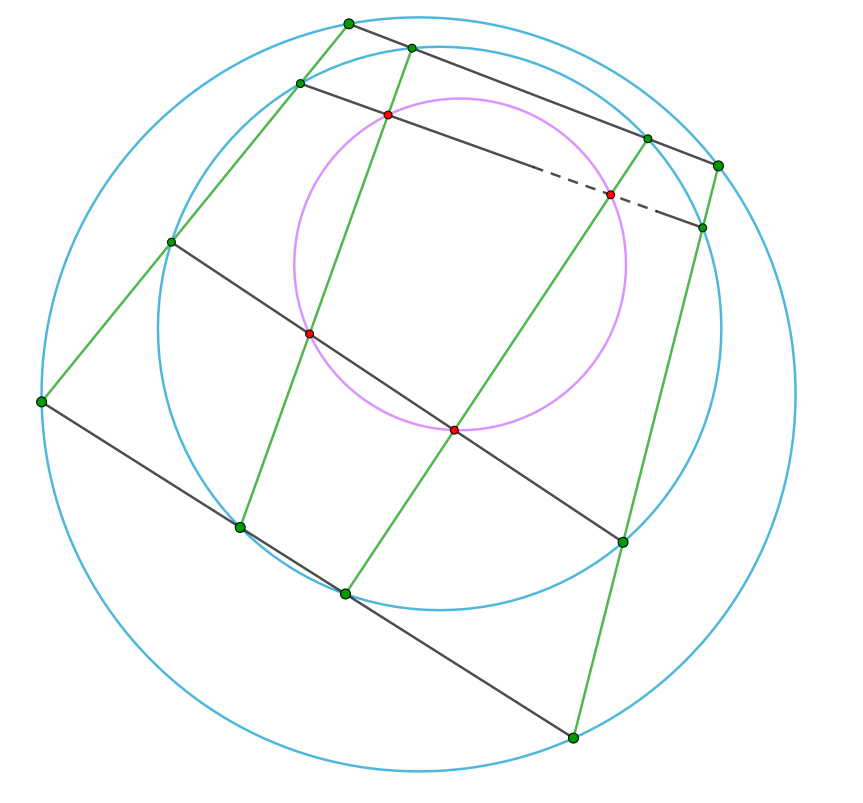In this post I will showcase a generalization of the famous 8 implies 9 theorem also known as Cayley-Bacharach. I will work over ![]() . The exposition is due to David Eisenbud, Mark Green, and Joe Harris in the paper “CAYLEY-BACHARACH THEOREMS AND CONJECTURES” posted in BULLETIN (New Series) of the american mathematical society (Volume 33, Number 3, July 1996). The original article can be found by a google search.
. The exposition is due to David Eisenbud, Mark Green, and Joe Harris in the paper “CAYLEY-BACHARACH THEOREMS AND CONJECTURES” posted in BULLETIN (New Series) of the american mathematical society (Volume 33, Number 3, July 1996). The original article can be found by a google search.
Main theorem. Let ![]() be plane curves of degree
be plane curves of degree ![]() and
and ![]() , respectively, intersecting in
, respectively, intersecting in ![]() points
points ![]() , and suppose that
, and suppose that ![]() is the disjoint union of subsets
is the disjoint union of subsets ![]() and
and ![]() . Let
. Let ![]() . If
. If ![]() is a nonnegative integer, then the dimension of the vector space of homogeneous polynomials of degree
is a nonnegative integer, then the dimension of the vector space of homogeneous polynomials of degree ![]() vanishing on
vanishing on ![]() (modulo those containing all of
(modulo those containing all of ![]() ) is equal to the failure of
) is equal to the failure of ![]() to impose independent conditions on homogeneous polynomials of degree
to impose independent conditions on homogeneous polynomials of degree ![]() .
.
Proof. See the article referenced.
Explaining the terminology. Suppose we have three distinct colinear points ![]() . Then the failure of
. Then the failure of ![]() to impose independent conditions on polynomials of degree
to impose independent conditions on polynomials of degree ![]() is equal to
is equal to ![]() , as a degree
, as a degree ![]() polynomial is a line which are determined by two points. In general, if
polynomial is a line which are determined by two points. In general, if ![]() is a finite set of points and
is a finite set of points and ![]() is minimal such that
is minimal such that ![]() of the
of the ![]() conditions suffices to imply all of them, we say that
conditions suffices to imply all of them, we say that ![]() imposes
imposes ![]() independent conditions on polynomials of degree
independent conditions on polynomials of degree ![]() . The failure of
. The failure of ![]() to impose independent conditions of is the number
to impose independent conditions of is the number ![]() .
.
If we let ![]() and
and ![]() , then we find
, then we find
Corollary. Let ![]() be plane curves of degree
be plane curves of degree ![]() and
and ![]() , respectively, intersecting in
, respectively, intersecting in ![]() points
points ![]() . If
. If ![]() is any plane curve of degree
is any plane curve of degree ![]() containing all but one point of
containing all but one point of ![]() , then
, then ![]() contains all of
contains all of ![]() .
.
Proof. Setting ![]() and
and ![]() in the main theorem, we readily see that the dimension of homogeneous polynomials of degree
in the main theorem, we readily see that the dimension of homogeneous polynomials of degree ![]() vanishing on
vanishing on ![]() is equal to the failure of
is equal to the failure of ![]() to impose independent conditions on homogeneous polynomials of degree
to impose independent conditions on homogeneous polynomials of degree ![]() . The latter being equal to
. The latter being equal to ![]() . Thus we conclude that there are no homogeneous polynomials of degree
. Thus we conclude that there are no homogeneous polynomials of degree ![]() containing
containing ![]() except these containing
except these containing ![]() (this is the interpretation of the “modulo those containing all of
(this is the interpretation of the “modulo those containing all of ![]() ” in the main theorem).
” in the main theorem).
If we set ![]() , we recover the classical Cayley-Bacharach theorem:
, we recover the classical Cayley-Bacharach theorem:
Theorem (Cayley-Bacharach). Let ![]() be cubic curves intersecting in
be cubic curves intersecting in ![]() points
points ![]() . If
. If ![]() is any cubic curve containing eight of the nine points, then it also contains the last point.
is any cubic curve containing eight of the nine points, then it also contains the last point.
“Application” Let us apply the main theorem to a problem from euclidian geometry. In the following diagram, we are asked to show that the red points lie on a circle:

Solution. We redefine by assuming the red points lie on a circle, and then prove that the last red point lie on a line as shown in the diagram below. Let ![]() be the union of the three circles and
be the union of the three circles and ![]() be the union of the four green lines and the line at infinity. These curves have degree
be the union of the four green lines and the line at infinity. These curves have degree ![]() and
and ![]() , respectively. As the three circles all pass through the imaginary circle points at infinity,
, respectively. As the three circles all pass through the imaginary circle points at infinity, ![]() and
and ![]() , we must count these two points trice thrice when taking the intersection
, we must count these two points trice thrice when taking the intersection

Now, let ![]() be the latter eight points in the intersection and
be the latter eight points in the intersection and ![]() the other
the other ![]() points. Pick
points. Pick ![]() . Now, as there’s always a cubic passing through
. Now, as there’s always a cubic passing through ![]() given points, we see that the dimension of the vector space of homogeneous polynomials of degree
given points, we see that the dimension of the vector space of homogeneous polynomials of degree ![]() vanshing on
vanshing on ![]() (modulo those containing all of
(modulo those containing all of ![]() ) is nonzero. Thus the failure of
) is nonzero. Thus the failure of ![]() to impose independent conditions on homogeneous polynomials of degree
to impose independent conditions on homogeneous polynomials of degree ![]() is nonzero. In particular, a degree
is nonzero. In particular, a degree ![]() curve passing through
curve passing through ![]() of the
of the ![]() points of
points of ![]() must pass through the last point. So we finish by taking
must pass through the last point. So we finish by taking ![]() as the union of the four black lines and the line at infinity.
as the union of the four black lines and the line at infinity.

Thank you for reading.
Very informative and well written
Great article! Do you have more resources on this topic?
This article was really insightful and easy to follow. I appreciate the clear explanations and the effort put into making it accessible. The examples provided helped me understand the topic better. I’ll definitely share this with others. Could you clarify the main takeaway from the section on implementation?